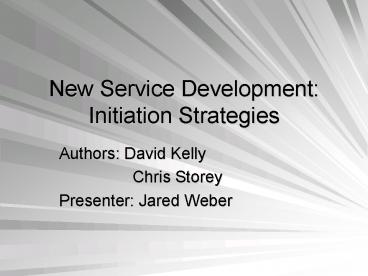New Service Development: Initiation Strategies - PowerPoint PPT Presentation
1 / 29
Title:
New Service Development: Initiation Strategies
Description:
New Service Development: Initiation Strategies Authors: David Kelly Chris Storey Presenter: Jared Weber What s the Purpose? There is plenty of information on NPD ... – PowerPoint PPT presentation
Number of Views:104
Avg rating:3.0/5.0
Title: New Service Development: Initiation Strategies
1
New Service Development Initiation Strategies
- Authors David Kelly
- Chris Storey
- Presenter Jared Weber
2
Whats the Purpose?
- There is plenty of information on NPD (New
Product Development) there is really nothing on
the NSD ( New Service Development). - Investigate how, and what extent, service firms
plan their search for new services. - Address the general approach service firms have
for NSD - The strategies used in choosing potential new
service projects.
3
Previous Work?
- None! No detail of previous studies.
- There is plenty of work on the NPD but none on
the NSD - Businesses are just now starting to realize the
importance of NSD
4
Idea Generation
- Evolves inside and outside the firm, formal and
informal search procedures (Cowell,1988) - Coming up with Ideas is relatively easy,
businesses tend not to engage in formal idea
generation (Easingwood, 1986)
- Whether new product strategy actually constrains
the search for new ideas? (Moore,1987) - Techniques for stimulating ideas must be created
and maintained on an ongoing basis to keep
generating innovations (Crawford, 1994)
5
Idea generation cont.
- The techniques should be embraced by the whole
firm (Vandermerwe, 1987) - Front-line personnel did not appear to play a
significant role in the early stages of NSD
(Brentani,1991) - Increased work load (Easingwood, 1986)
- Competitors have been identified as a more
important source of ideas than customers.
(Easingwood, 1996) - 80 of banks view their competitors as main
source of new product ideas (Teixeria and
Ziskin,1993)
6
Screening
- Allocate resources between projects which most
likely would help the firm meet its objectives? - Can be a single activity or multi-stage, can be
quantitative or qualitative. - Done at the early stages of NSD, therefore a
shortage of hard facts.
- Should be refined to reflect the firm (Choffray
and Lillien, 1980) - Decisions will always be plagued by a high degree
of uncertainty and subjectivity. (Cooper,1981) - Hidden cost to failure managerial effort wasted,
corporate image, missed opportunities for new
products.
7
Aim of the research
- Investigate whether service firms use systematic
procedures to generate and screen ideas for new
services.
8
Research Method
- Questionnaire given to Leading UK service firms
in five different sectors. (Banking,
Telecommunications, Insurance, Transportation and
Media) - Sent to marketing personnel
- Followed by interviews.
9
Research Cont.
- 43 executives respond from a sample of 154.
- Response rate of 28
- 57 marketing/product development directors
- 21 marketing or product managers
- 21 general management positions
10
Questionnaire
- New products were defined as
- Core products that are new-to-the-world or new to
the company. - Core products that are improvements over existing
products. - Supplementary and value-added services.
11
Results
- Respondents asked to categorize themselves
according to the Miles and Snow (1978) approaches
to innovation - (1) Prospector. Values being "first" with new
products, markets and technologies. - (2) Analyzer. Seldom first to market, but
frequently a fast follower with a more
cost-efficient or innovative product - (3) Defender. Locates and maintains a secure
niche by protecting their position in a
relatively stable product or service area. - (4) Reactor. Responds to product and market
changes only when forced by environmental
pressures.
12
(No Transcript)
13
(No Transcript)
14
(No Transcript)
15
Key Barriers to Effective Service Development in
a Firm
16
Idea Generation Starting Point
- 3 new questions
- Whether new product ideas were generated
continuously or just needed - Whether the firm has a formal idea search
methodology - Whether the idea search methodology is documented
17
(No Transcript)
18
Open Question
- Criteria used to evaluate new product ideas?
- 74 different criteria
- Categorized into five common themes.
19
(No Transcript)
20
(No Transcript)
21
(No Transcript)
22
(No Transcript)
23
(No Transcript)
24
(No Transcript)
25
(No Transcript)
26
Findings
- NSD is risky yet the revenue is good for those
who use it. - Firms will find it difficult to generate new
project proposals to remain competitive if NSD is
not implemented - Need for the development of systems and processes
that stimulate idea generation in a firm
- Main barrier to innovation in service firms is
the lack of expertise within the firm. - Marketing Department is the source for large
percentage of new service ideas - Operations and Customer Service personnel are not
actively involved as they should be.
27
Findings
- Found idea screening to be carried out more
systematically than idea generation and basing
their decision to proceed on financial criteria. - Lack of resources is a common barrier to NSD.
Result in spreading resources too thin. - Need to pick projects that can be effectively
carry out with the resources available.
28
Further Research
- Identify the relevance of different NSD process
models for different types of services and in
different industrial settings.
29
Conclusion
- NSD is an informal processes compared to NPD.
- Firms are missing out of opportunities
- Few firms systematically involve contact or
operations staff in the process (Goes against
services marketing theory)
- Screening process needs to be improved to pick
winners and prioritize projects. - Service firms are not satisfied with their
ability to develop new services.































